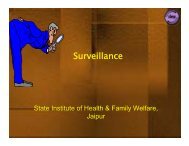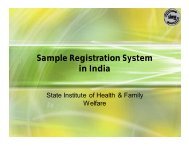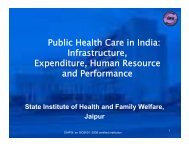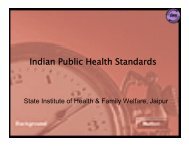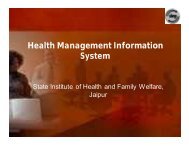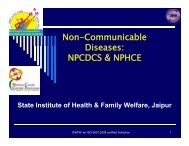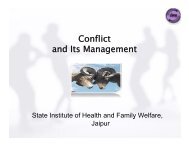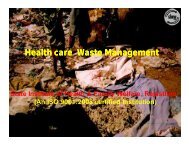E-News Letter Volume Second , Issue Fourth ... - SIHFW Rajasthan
E-News Letter Volume Second , Issue Fourth ... - SIHFW Rajasthan
E-News Letter Volume Second , Issue Fourth ... - SIHFW Rajasthan
- No tags were found...
Create successful ePaper yourself
Turn your PDF publications into a flip-book with our unique Google optimized e-Paper software.
Prevention<br />
Vector control is the main way to reduce malariaa transmissionn at the community level. Vector control<br />
is an<br />
intervention that can reduce malariaa transmission from extremely high levels to extremely low levels. For<br />
individuals, personal protection against mosquito bites represents the first line of defense for malaria<br />
prevention. Two forms of vector control are effective in a wide<br />
range of circumstances.<br />
1. Insecticide-treated<br />
mosquito nets (ITNs): Long-lasting insecticidal nets<br />
(LLINs) are the preferred<br />
form<br />
of ITNs for public health distribution programmes. WHO recommends<br />
coverage for all at-risk persons;<br />
and in<br />
most of the<br />
settings. The most cost effective way<br />
to achieve this is through provision of free<br />
LLINs, so that everyone sleeps under a LLIN<br />
every night.<br />
2. Indoor spraying with residual insecticides: Indoor residual spraying<br />
(IRS) with insecticidess is a<br />
powerful way to rapidly reduce malaria transmission. Its full potential is when at least 80% of houses<br />
in targeted areas are sprayed completely. Indoor spraying is effectivee for 3–6 months, depending on<br />
the insecticide used and the type of surface<br />
on which it<br />
is sprayed. DDT can be effective for 9–12<br />
months in some cases. Longer-lasting forms of existing IRS insecticides, as well as new classes of<br />
insecticides for use<br />
in IRS programmes, are under development.<br />
Clinical Prevention<br />
• Antimalarial medicines can be used to prevent malaria.<br />
• For travelers, malaria<br />
can be prevented<br />
through<br />
chemoprophylaxis,<br />
which suppresses the blood stage of<br />
malaria infections, thereby preventing malaria disease.<br />
• In addition, WHO<br />
recommends intermittent preventive<br />
treatment with Sulfadoxine-pyrimethaminee for pregnant<br />
women living in high transmission areas, at each<br />
scheduled antenatal visit after the first trimester. Similarly,<br />
for infants living in high-transmission areas of Africa, 3<br />
dosess of intermittent preventivee treatment with sulfadoxine-<br />
pyrimethamine<br />
is<br />
recommended<br />
delivered<br />
alongside<br />
routine vaccinations.<br />
General Strategy for Prevention and Control of Vector<br />
Borne Diseases<br />
Some of the control strategies proposed for the<br />
next five-year<br />
plan i.e. 12 Five Year<br />
Plan are:<br />
• Early Diagnosis and Complete Treatment<br />
• Integrated Vector Management<br />
(IRS, LLIN, Fish chemical<br />
and bio- larvicide, source reduction)<br />
• Supportive Intervention<br />
• Behaviour Change<br />
Communication<br />
• Improving Surveillance in high endemic areas<br />
• Strengthening microscopy services at PHCs along with<br />
quality<br />
assurance<br />
both for microscopy<br />
and Rapid<br />
Diagnostic Test (RDT) and complete treatment of malarial<br />
casess and deaths<br />
World Health<br />
Day-7 April<br />
2013<br />
World Health Day is celebrated<br />
on 7 April<br />
every year on anniversary of the<br />
founding of<br />
WHO in 1948. Every year a theme is<br />
selected that highlights a priority area of<br />
public Health concern in the world. The<br />
theme for this year is High Blood Pressure.<br />
High Blood Pressuree is also known as raised<br />
BP of Hypertension-increases<br />
the risk of<br />
heart attacks, strokes and kidney failure. If<br />
left uncontrolled, high blood pressure can<br />
also cause blindness, irregularities of the<br />
heartbeat and heart<br />
failure. Though it affects<br />
more than one in three adults worldwide, it<br />
remains largely hidden. Many people do not<br />
know they have high blood<br />
pressure<br />
because it does<br />
not always<br />
cause<br />
symptoms. As a result, it leads to more than<br />
nine million deaths<br />
every year, including<br />
about half of all deaths due to heart disease<br />
and stroke.<br />
Source: WHO



